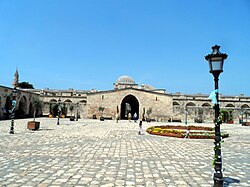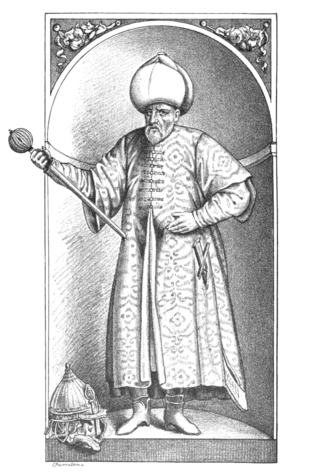
Sokollu Mehmed Pasha was an Ottoman statesman most notable for being the Grand Vizier of the Ottoman Empire. Born in Ottoman Herzegovina into an Orthodox Christian Serbian family, Mehmed was forcibly recruited as a young boy as part of so called "blood tax" to serve as a janissary to the Ottoman devşirme system of recruiting Christian boys to be raised as officers or administrators for the state. He rose through the ranks of the Ottoman imperial system, eventually holding positions as commander of the imperial guard (1543–1546), High Admiral of the Fleet (1546–1551), Governor-General of Rumelia (1551–1555), Third Vizier (1555–1561), Second Vizier (1561–1565), and as Grand Vizier under three sultans: Suleiman the Magnificent, Selim II, and Murad III. He was assassinated in 1579, ending his near 15-years of service to several Sultans, as sole legal representative in the administration of state affairs.

Mimar Sinan also known as Koca Mi'mâr Sinân Âğâ, was the chief Ottoman architect and civil engineer for sultans Suleiman the Magnificent, Selim II and Murad III. He was responsible for the construction of more than 300 major structures such as the Selimiye Mosque in Edirne, the Kanuni Sultan Suleiman Bridge in Büyükçekmece, the Mehmed Paša Sokolović Bridge in Višegrad, and other more modest projects such as madrasa's, külliye's, bridges, etc. His apprentices would later design the Sultan Ahmed Mosque in Istanbul and Stari Most in Mostar.

Fatih is a district of and a municipality (belediye) in Istanbul, Turkey, and home to almost all of the provincial authorities but not the courthouse. It encompasses the peninsula coinciding with old Constantinople. In 2009, the district of Eminönü, which had been a separate municipality located at the tip of the peninsula, was once again remerged into Fatih because of its small population. Fatih is bordered by the Golden Horn to the north and the Sea of Marmara to the south, while the Western border is demarked by the Theodosian wall and the east by the Bosphorus Strait.
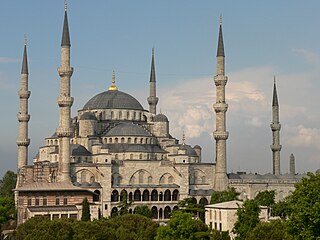
Ottoman architecture is the architectural style that developed under the Ottoman Empire. It first emerged in northwestern Anatolia in the late 13th century and developed from earlier Seljuk Turkish architecture, with influences from Byzantine and Iranian architecture along with other architectural traditions in the Middle East. Early Ottoman architecture experimented with multiple building types over the course of the 13th to 15th centuries, progressively evolving into the Classical Ottoman style of the 16th and 17th centuries. This style was a mixture of native Turkish tradition and influences from the Hagia Sophia, resulting in monumental mosque buildings focused around a high central dome with a varying number of semi-domes. The most important architect of the Classical period is Mimar Sinan, whose major works include the Şehzade Mosque, Süleymaniye Mosque, and Selimiye Mosque. The second half of the 16th century also saw the apogee of certain decorative arts, most notably in the use of Iznik tiles.

The large Fatih Mosque is an Ottoman mosque off Fevzi Paşa Caddesi in the Fatih district of Istanbul, Turkey. The original mosque was constructed between 1463 and 1470 on the site of the Church of the Holy Apostles. Seriously damaged in the 1766 earthquake, it was rebuilt in 1771 to a different design. It is named after the Ottoman sultan Mehmed the Conqueror, known in Turkish as Fatih Sultan Mehmed, who conquered Constantinople in 1453.

Sokollu Mehmed Pasha Mosque is a 16th-century Ottoman mosque in the Kadırga neighborhood in Fatih district, Istanbul, Turkey. It was commissioned jointly by the grand vizier Sokollu Mehmed Pasha and his wife İsmihan Sultan. It was designed by the imperial architect Mimar Sinan and completed in 1571/2. The mosque is noted for the fine quality of the Iznik tiles that decorate the interior walls.
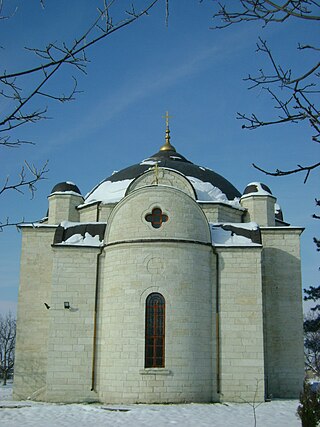
The Church of the Dormition of the Holy Mother of God (Bogoroditsa) is a Bulgarian Orthodox church in the village of Uzundzhovo, Haskovo Municipality, Bulgaria. Built as a mosque during the Ottoman era, it was reconstructed in 1906 as a church.
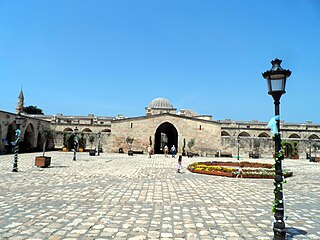
Payas is a town in the Hatay Province of Turkey.

Büyük Han is the largest caravansarai on the island of Cyprus and is considered to be one of the finest buildings on the island. Located in the capital of Cyprus, it was built by the Ottomans in 1572, the year after they had seized Cyprus from the Venetians. In the centre of the open courtyard is a mosque with a fountain for pre-prayer ablutions. It became the first city prison under British administration. After spending most of the 1990s being restored, the inn has been revived as a thriving arts centre, consisting of several galleries and workshops. There are also several courtyard cafes and souvenir shops.

Pertev Mehmet Paşa Mosque, also known as Yeni Cuma Cami meaning "New Friday Mosque" in Turkish, is a 16th-century Ottoman mosque in the town of Izmit, Turkey. The architect was Mimar Sinan. It was built for Pertev Mehmed Paşa, an Ottoman vizier during the reigns of sultan Suleyman I and Selim II. The construction was finished in 1579. The mosque is part of a larger complex (Külliye) which originally included a madrasa, hammam, caravanserai, fountain and a lower education school. The mosque itself is a single domed structure and the dome has 24 windows. The minaret was damaged during the 1999 İzmit earthquake.
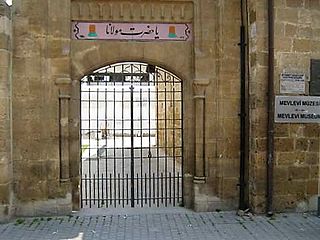
Mevlevi Tekke Museum is a tekke in Nicosia, Cyprus, currently in North Nicosia. It has historically been used by the Mevlevi Order and now serves as a museum. It is one of the most important historical and religious buildings in the island. It is located next to the Kyrenia Gate, on Girne Avenue, in the İbrahimpaşa quarter.
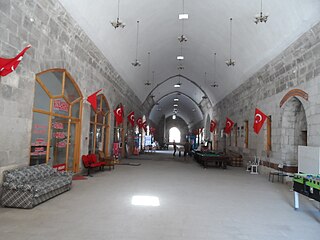
Öküz Mehmet Pasha Complex, alternatively known as Öküz Mehmet Pasha Caravanserai, is a külliye in Ulukışla, Turkey. According to Ulukışla municipality page the name Ulukışla refers to the complex. In the past a part of the complex was used as military barracks and the Ulukışla citizens called the complex Ulukışla which eventually became the name of the settlement.
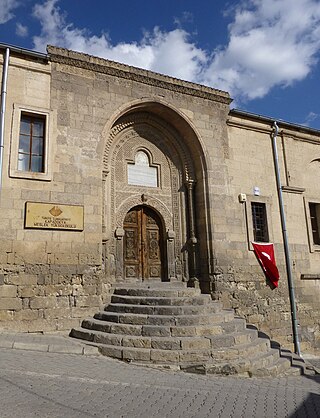
Medrese of Mehmet Şakir Paşa, also known as Madrasa of Mustafapaşa is a 19th-century madrasa, an Islamic educational institute, in Nevşehir Province, central Turkey. It is also known as a caravanserai.

The Sokollu Mehmed Pasha Mosque is a 16th-century Ottoman mosque located in Istanbul, Turkey.

The Sokollu Mehmed Pasha Mosque, also known as the Köprübaşı (Bridgehead) Mosque, is the ruin of a 16th-century Ottoman mosque located in Istanbul, Turkey.
The Sokollu Mehmed Pasha Mosque is a 16th-century Ottoman mosque located in the town of Lüleburgaz in the Kırklareli Province of northwestern Turkey.
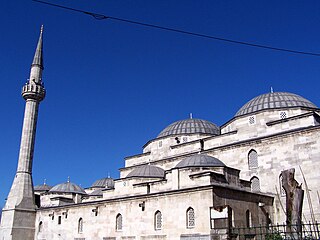
The Mahmut Pasha Mosque is a 15th-century Ottoman mosque near the Grand Bazaar in the Fatih district of Istanbul, Turkey.

The Kürkçü Han is a large historic han (caravanserai) in Istanbul, Turkey. Founded by Mahmud Pasha, the grand vizier of Mehmet II, it was completed in 1467 and is the oldest surviving caravanserai in the city, although it has been modified, partly ruined, and renovated over the centuries.

Classical Ottoman architecture is a period in Ottoman architecture generally including the 16th and 17th centuries. The period is most strongly associated with the works of Mimar Sinan, who was Chief Court Architect under three sultans between 1538 and 1588. The start of the period also coincided with the long reign of Suleiman the Magnificent, which is recognized as the apogee of Ottoman political and cultural development, with extensive patronage in art and architecture by the sultan, his family, and his high-ranking officials. Ottoman architecture at this time was strongly influenced by Byzantine architecture, particularly the Hagia Sophia, and blended it with other influences to suit Ottoman needs. Architects typically experimented with different combinations of conventional elements including domes, semi-domes, and arcaded porticos. Successful architects such as Sinan demonstrated their skill through their meticulous attempts to solve problems of space, proportion, and harmony. Sinan's most important works include the Şehzade Mosque, Süleymaniye Mosque, and Selimiye Mosque. After his death, the classical style became less innovative and more repetitive. The 17th century still produced major works such as the Sultan Ahmed Mosque, but the social and political changes of the Tulip Period eventually led to a shift towards Ottoman Baroque architecture.
